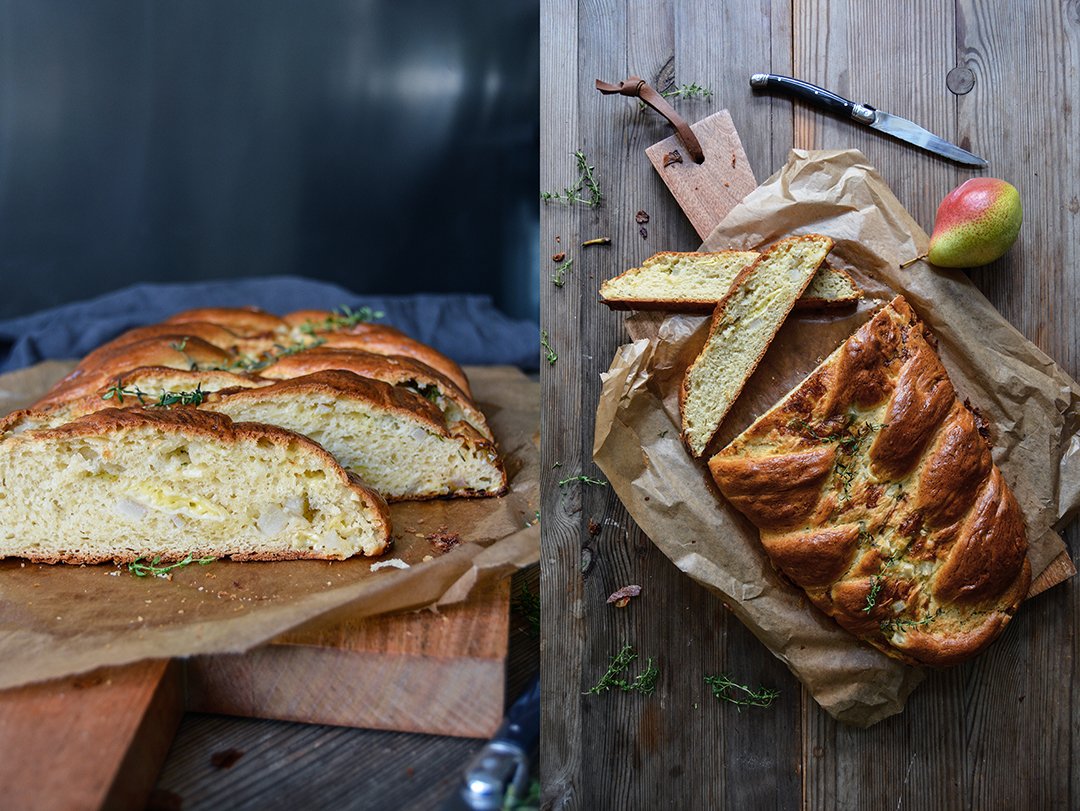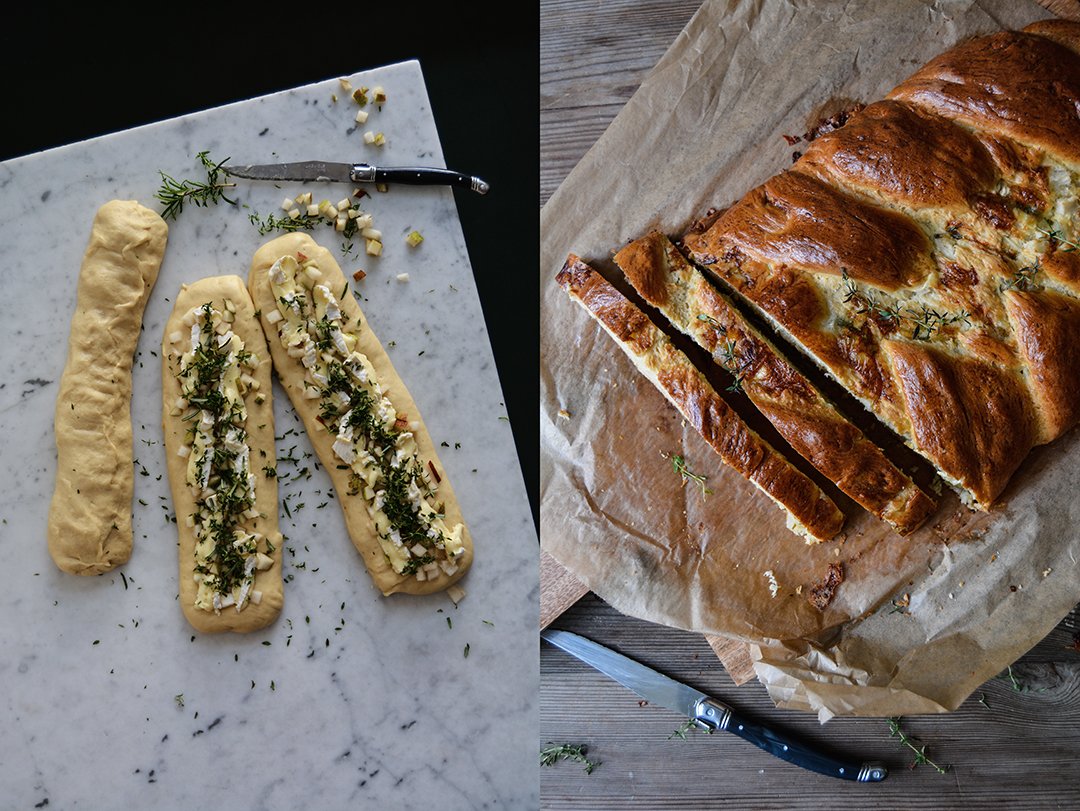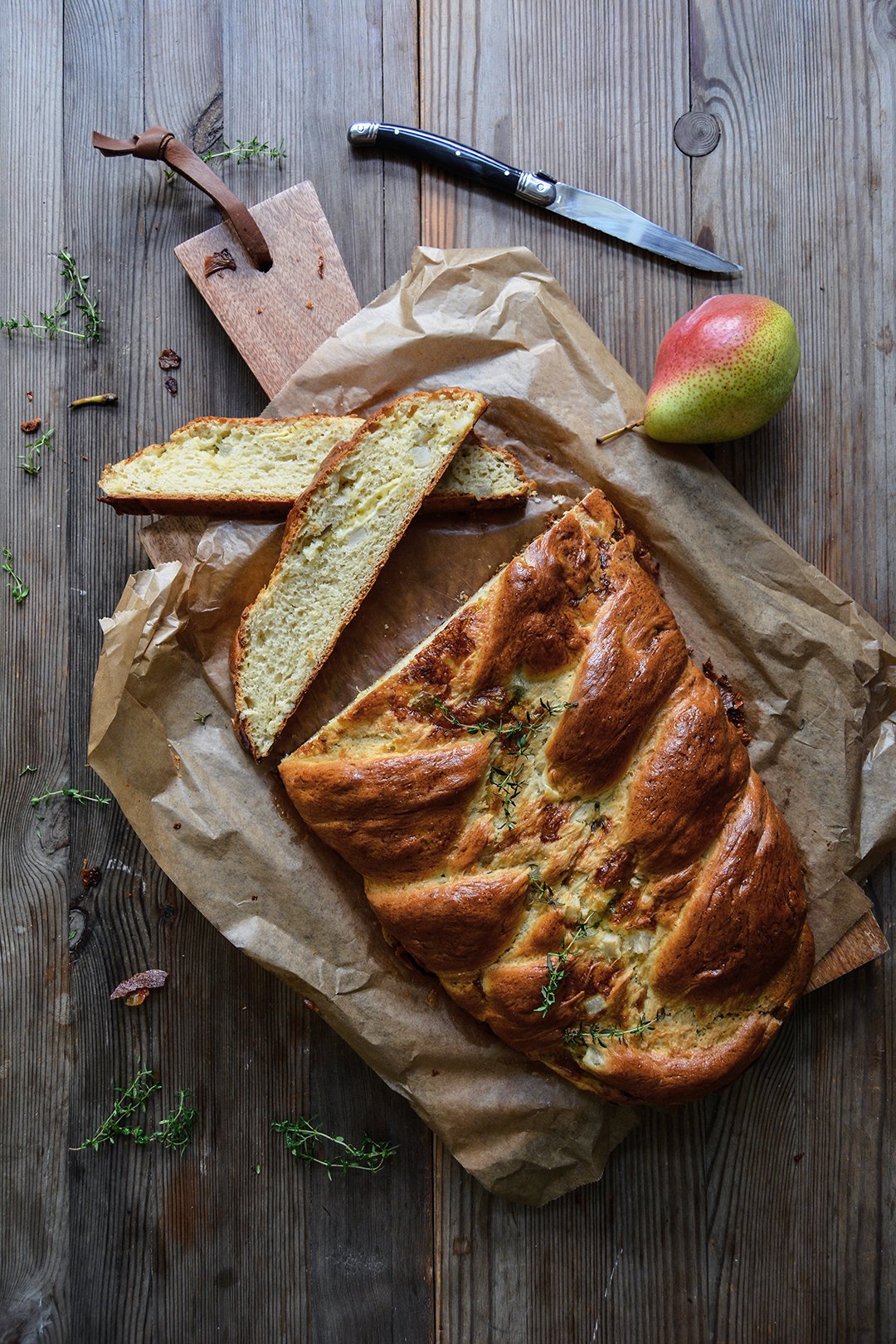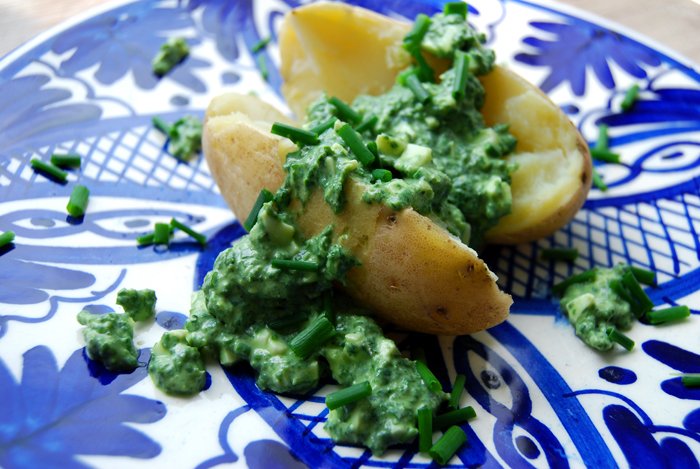Camembert, Pear and Thyme Challah
A lot of cracking and aching was going on in the oven while I watched my camembert, pear, and thyme challah bake. At one point I got worried that my braided bread was going to explode. It rose and expanded on all sides, it looked more like a challah pancake than the elegant breaded loaf I had in mind. Maybe I filled the single yeast dough strings a bit too generously with ripe - and stinky - cheese and chopped crisp fruit, but I had a feeling that the recipe needed it. So I trusted, which is always the only sensible thing a baker can do when the object of attention doesn't perform as expected.
To my surprise, it worked out in the end and the shape still reminded me of a Hefezopf - the German name for challah. I used my classic plain challah recipe and replaced the sugar with honey. It's common in Germany to use butter and milk for this kind of bread, instead of water and vegetable oil, which you usually find in traditional challah recipes. I like the added richness coming from the dairy products, I find it tastier. Seeing as the fruit and cheese bring in even more juice and moistness, I could have made the dough a bit drier, added more flour to help it keep its shape. But the final texture was so nice, soft and spongy, that I'd rather accept the pancake-look than ending up with a dry Hefezopf.
If you don't feel like camembert, you can also go for any other aromatic cheese that melts well. I already have a raclette challah in mind, next time. And I'm sure that apricots or peaches would also do a pretty good job instead of the pear. So feel free to experiment, but keep in mind, the juicier the fruit, the more it'll soften your dough.
This challah is a perfect picnic, brunch, or Saturday lunch treat, preferably accompanied by fresh fruits, wine, and a selection of cheese and prosciutto. A green salad with juicy tomatoes also goes very well with it.
Camembert, Pear and Thyme Challah
When I baked my challah, it was a very hot day. So the butter in the dough literarily melted in my hands and turned braiding into a fiddly task. The single braids stretched quicker than I reacted, I was too slow. If you also happen to go for this recipe on a day with high temperatures, to avoid stress and frustration, try to work quickly when you braid the loaf. Keep the braids a bit shorter to begin with, due to the filling they'll expand in length.
Makes 1 large challah
honey 2 tablespoons
butter, melted, 100g / 1/3 cup plus 2 tablespoons
milk, lukewarm, 150ml / 2/3 cup
organic eggs 2
plain flour 520-550g / 4 cups - 4 cups plus 4 tablespoons
fast-acting yeast 1 sachet (7g / 1/4 ounce)
fine sea salt 1 teaspoon
For the filling
aged camembert, cooled and cut into thin strips (it'll be a mess if it's too soft), 250g / 9 ounces
medium to large firm pear, cored and cut into tiny cubes, 1
fresh thyme and a little rosemary (the needles, chopped), a large handful
For the glaze
organic egg yolk 1
water 1 tablespoon
Stir the honey into the hot melted butter and whisk until combined, let it cool until it's lukewarm. Add the milk and eggs and whisk, the mixture should be lukewarm.
In a large bowl of a stand mixer fitted with the hook attachment, combine the flour, yeast, and salt. Add the milk-butter mixture to the flour mixture and mix for about 5 minutes or until well combined and smooth. If it's too soft and sticky, add a little (!) more flour. Continue kneading and punching with your hands for about 3-5 minutes or until you have a soft and silky ball of dough. Place the dough back in the bowl, cover with a tea towel, and let rise in a warm place, or preferably in a 35°C (100°F) warm oven, for 60-70 minutes or until almost doubled in size. If it's a hot summer day, you can let the dough rise at room temperature (that's what I did this time).
Line a baking sheet with parchment paper.
When the dough is puffy and almost doubled in size, punch it down, take it out of the bowl, and knead for about 30 seconds. Divide into 3 parts and roll them into longish, but not too thin sausage sausage shapes (see picture above). Flatten each piece of dough until it's roughly 7.5 cm / 3" wide. Divide the camembert, pear, and herbs between the 3 pieces of dough and spread, leaving a little rim all around the filling. Fold over each piece of dough, roll it gently, and seal the overlapping side and ends well. The filling should be completely wrapped inside the dough.
To braid the bread, work quickly, as the dough stretches. Lay the ends of the dough rolls on top of each other at one end and braid them tightly. If they become too long and thin, squeeze them together a little. Bend both ends of the bread under the loaf and quickly transfer to the lined baking sheet. Cover with a tea towel and let rise in a warm place for about 40-50 minutes or until fluffy.
Preheat the oven to 190°C / 375°F (conventional setting).
For the glaze, whisk the egg yolk and water and brush the top of the challah. Bake for about 25-30 minutes or until golden brown and spongy. When you knock on the challah's bottom, it should sound hollow. Let it cool for a few minutes before cutting the bread into thick slices.The challah tastes best on the 1st day.
A quick Fish Soup with Saffron and Vermouth
Bright red, with chunks of firm fish filet and king prawns, this was one of the best fish soups I have ever eaten! It was so rich in aromatic flavours, saffron, vermouth, thyme and bay leaf that it makes my mouth water when I think about it. My mother cooked the soup with wolfs fish and cod, we went to the market to get monkfish but her fish monger didn't have it that day. Our choice was good, the fish tasted nice and strong and we enjoyed every single bite of it!
The soup is made of a concentrated fish broth, lobster works as well, which you can either prepare yourself beforehand or use a store bought one of good quality (my mother used a broth she had in the freezer). Once you have the broth ready in the pot, the basis of this soup, you only need 20 minutes in the kitchen before you can fill your plates with this delicious fish soup. We added saffron, vermouth, herbs and a couple vegetables and let it simmer for 10 minutes before we threw in the fish for another 7 minutes, that's it. A sumptuous meal in such a short time!
Traditionally, this soup is topped with mayonnaise, you can either use the one from yesterday's artichoke with 3 dips or my garlicky aïoli. The traditional Provençal Bouillabaisse is served with an aromatic Rouille (I haven't shared a recipe for this yet) which is made with saffron and spicy chili peppers. We got so excited over the quick preparation of our soup and the beautiful German white wine we already savored while cooking, that we simply forgot about this creamy dip. We didn't enjoy it any less without it, with ciabatta bread on the side and the most amazing view of soft hills in juicy shades of green behind my mother's blossoming garden. It was a good day!
Fish Soup with Saffron and Vermouth
For 4 people you need
fish ( firm filets of loup de mer, monkfish, wolfs fish or cod and king prawns), cut into chunky pieces, 800g / 1 3/4 pounds
fish or lobster broth 1200ml / 2.5 pints
vermouth 100ml / 3.5 ounces (we used a mix of Noilly Prat and Pernot)
shallots, finely chopped, 2
medium carrot, finely chopped, 1
garlic, crushed, 1 clove
tomato paste 2 tablespoons
thyme, the leaves of 3 sprigs
parsley, finely chopped, the leaves of 3 sprigs
bay leaf 1
a pinch of saffron
a pinch of cayenne pepper
salt and pepper
olive oil
In a large pot, heat a splash of olive oil and sautée the vegetables and garlic on a medium heat for 2 minutes. Add the tomato paste and mix with the vegetables. Deglaze with the vermouth and let it cook for 1 minute. Add the broth, bay leaf, thyme and parsley and let it cook for 10 minutes on a medium heat. Season with saffron, cayenne pepper, salt and pepper to taste and take out the bay leaf.
Add the fish and let it simmer on a medium-low heat for about 7 minutes until the fish is done. Don't overcook it, the texture should stay firm.
Serve with white bread (you can also roast it under the grill with a few drops of olive oil) and a spoonful of mayonnaise.
Frankfurt Green Sauce - 7 Herbs and Spring Potatoes
Sorrel, borage, chervil, burnet, parsley, chives and garden cress, these are the 7 herbs which make up the traditional Frankfurt Green Sauce. Similar to the Italian Salsa Verde or the French Sauce Verte, which are also mainly made of herbs, the famous German version is made of greens growing in the Frankfurt area. Legend has it that the origin of the green herbal sauce is in the Orient and it was brought to Europe by the Romans more than 2000 years ago, enough time for each region to create their own, unique recipes. Apart from the right selection of herbs, there isn't "one" recipe for this sauce from Frankfurt. They all vary, some add heavy cream, sour cream, yoghurt or mayonnaise, some are made with onions, garlic or mustard, but most involve a hard boiled egg.
I developed my own recipe a few years ago when I used to live close to the city of the sauce's origin. To me, the sauce needs 2 crumbled hard boiled eggs, sour cream, olive oil, lemon juice, a little heavy cream for some sweetness, white Balsamico vinegar and salt and pepper, but the focus is definitely on the herbs, you need a lot, 200g / 7 ounces in total!
Traditionally the cold sauce is eaten with boiled spring potatoes, some serve it with cold meat but I prefer to keep it simple and light, the sauce is so fragrant and aromatic that the mild potatoes fit just perfectly.
Frankfurt Green Sauce with Spring Potatoes
For 2-3 people you need
medium sized potatoes, boiled and peeled, 4-6
For the sauce
mixed herbs (sorrel, borage, chervil, burnet, parsley, chives and garden cress) 200g / 7 ounces
organic eggs, hardboiled, chopped finely, 2
sour cream 5 tablespoons
olive oil 2 tablespoons
freshly squeezed lemon juice 2 tablespoons
heavy cream 1 tablespoon
white balsamic vinegar 1 tablespoon
salt and pepper
Chop the herbs with a knife finely or mix in a blender. Put the herbs in a big bowl and add the eggs, sour cream, heavy cream, olive oil, lemon juice and vinegar and stir until combined. Season with salt and pepper to taste and serve on top of the potatoes.
Aïoli and Wild Herbs Sandwich
When I went to Ibiza for the first time I got absolutely hooked on aïoli, I ate it every single day! It's more than twenty years ago and I had just turned thirteen. I was so happy to spend some time with my best friend at her parent's holiday home, it felt exciting to be on this island which is so famous for its parties (which I couldn't join as I was still too young)! I especially enjoyed the nights out at all the amazing restaurants we visited together, I have always loved Spanish food, tapas and barbecues, but in those days I was particularly fond of Ibiza's traditional appetizer, fresh bread and aïoli. In Spain, people usually go to restaurants quite late, at 9 or 10 in the evening, by that time I was already starving. As soon as we sat down and a basket full of warm bread and a bowl of creamy aïoli was brought to the table, nothing could stop me from emptying both!
It took me a while to make my own aïoli, a few years ago we had friends over from Barcelona and they introduced me to the traditional dip's secrets. It's surprisingly quick and easy to prepare:
For 4 sandwiches you drop 2 egg yolks into a mug which should be just big enough for a stick mixer to fit in it. You mix 3 crushed cloves of garlic with 4 teaspoons of freshly squeezed lemon juice in one bowl, and measure 100ml / 3.5 ounces of good quality olive oil in another. Pour 1/4 of the oil onto the egg yolks and start mixing with the stick mixer, add more oil and the lemon garlic mixture, a little at a time, mixing constantly. When the dip is thick and creamy season with salt. Spread on 4 thick slices of white bread and sprinkle with mixed wild herbs. I found a fantastic mixture of wild herbs which I don't use often, saltbush (orache), burnet, rucola, pigweed, edible chrysanthemum, yarrow, cheeseweed and chickweed. Every bite brought in new flavours, all strong and delicious together with the aïoli!
A Fried Egg and Bacon Sandwich with Tarragon and Parsley
One morning we decided to "decorate" our fried eggs with fresh herbs and it became a morning classic in our kitchen. It looks really pretty and tastes even better. The variations are endless and change all the time depending on the herbs growing in our terracotta pots, and there are plenty at the moment! Usually the small plants don't survive the cold winter, the roots aren't really as protected as they should be. I tried to keep the herbs inside on my kitchen window sill during the cold season but they tend to suffer from bugs and mildew, so I gave up. I wish them the best of luck, protect them with some leaves and hope for the best. To my surprise, a fragile, skinny tarragon plant, an offshoot which I dug out of my mother's herb garden managed to bear the cold and frost and it's shining again in its recaptured bloom and beauty. I love its strong aroma which reminds me a bit of aniseed.
For my fried eggs, I picked a few of the tarragon's long leaves, about 6 slim ones for each egg, and some crunchy parsley, the Italian one with big flat leaves. The combination works well, I just went easy on the parsley, 2-3 leaves per egg were enough as it can easily be too overpowering. I fried the eggs in a little butter on medium heat in a non-stick pan, put the herbs gently on top of the liquid egg whites and yolks and covered the pan with a big lid until the whites turned solid. I kept the egg yolk soft as I wanted it to soak into the hearty bread when I cut it open. To finish off my sandwich, I fried 3 slices of bacon golden brown and crisp and put a few slices of my dark spelt bread into the pan as well. When you roast the bread in the fatty juices, just in the end for a minute or two, it becomes a bit crunchy and is infused with the meaty aroma. I didn't add any salt, just crushed black pepper, thanks to the strong bacon!































